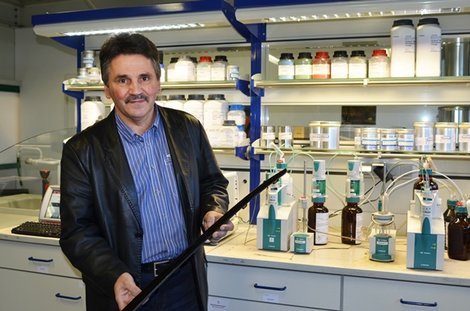Self-healing coating systems – such as “ColorForm”

which is revolutionising the production of components in a high-gloss finish
A convincing product and plenty of patience – both are required to turn an idea into a success. Panadur GmbH had confidence in its development, found the right partners, and now, six years after the start of its project with the name of “ColorForm”, it has every right to be proud of its success. “We have succeeded in becoming part of the automotive industry,” explains managing director Dr. Thomas Moch.
At a Halberstadt industrial estate just a few hundred meters from the headquarters of Panadur, their success is plain to see: an auto dealer is presenting the new Peugeot 3008 SUV, whose black A-pillar cladding is shimmering in the sun. “It’s the first ever series use of our ColorForm process in the world,” explains Thomas Moch. “The process is revolutionising the manufacturing of components that have a high gloss finish, because the technology combines injection moulding and reaction technology, and also enables fully automatic manufacturing in a single-stage production cycle.”
Panadur has guided the process to series maturity together with the mechanical engineers KraussMaffei and additional project partners. The company Weidplas GmbH in Switzerland has now been manufacturing the A-pillar cladding for Peugeot since June, the high gloss black surface finish of which is produced directly in the injection moulding tool. It acts as a seal between the windscreen and the pillar of the SUV and also functions as a stylish design element on the range of vehicles which is oriented towards the premium market. “I am certain that this is just the start and that more vehicle manufacturers will follow,” says Thomas Moch.
He has convincing arguments: the cleaning, priming and coating stages which are otherwise required in conventional coating processes are all omitted in the ColorForm process. This enables the industry to save energy, time and costs. “The coating process, which means the flooding of the carrier component with our coating, takes less time than the production of the uncoated supporting material, which takes place in the same processing step. The coating hardens within just a few seconds,” explains Thomas Moch. “The component which comes out of the machine can be installed immediately.”
Sector professionals have been impressed. At the end of October, together with KraussMaffei, Panadur attended the “K 2016” in Düsseldorf, the world's leading trade fair for the plastics and rubber industry, where they put the latest results of their shared development on display. The telephones have barely stopped ringing at Panadur in Halberstadt ever since and Thomas Moch is looking to the future with a sense of optimism: “If things carry on like this we’ll have to increase our production capacity. We will need a bigger production hall.”
One of the key attributes of the Panadur products is that the coatings don't contain any solvents. “That’s our technological advantage. We are the only company in the world to manufacture coatings of this kind,” says Thomas Moch, before adding with a cheeky grin: “Who would have thought it, from a small company out here in the middle of nowhere?”
The company in Halberstadt is indeed small, and has just 19 employees. Its research and development department is home to six specialists, including several chemists and the director himself, who is also a trained physicist. “I want to advance innovations,” he explains, stating his motivation. He is a huge fan of perfect surfaces – without streaks and wrinkles, which is also known as "orange skin" in the plastic surfaces terminology.
The Polyurea coating material used by Panadur enables completely uniform surfaces – from piano lacquer black, to metallic, to transparent, every colour is possible. The finest structures of the component also remain visible. For the automotive manufacturers, above all else, attributes such as high scratch resistance, weather resistance and colour consistency are of decisive importance. The 2- and 3-component coating systems for interiors and exteriors have passed all of these tests. “The automotive manufacturers also test the resistance to bird droppings, cleaning products and even suntan lotion,” lists Thomas Moch. The latest development by Panadur GmbH is a self-healing coating system on which small scratches to the surface disappear autonomously after a brief period of time.
He tells us that the road to securing contracts in the automotive supplier industry was a long one, but that the start has now been made. From 2017 onwards, Panadur is to supply its products to Opel – and the managing director has also presented the Panadur ColorForm coating systems to prospective customers in the USA, Spain and Korea to considerable interest. The technology is also of interest to the consumer goods industry, and in addition to other products, for plastic-coated white goods. “I am convinced that business will boom,” explains Moch.
Right now, his expansion plans for the Halberstadt location are just an idea. Moch, who hails from nearby Magdeburg, is committed to the local Vorharz region, and wants to stay there. “Of course, a bigger city would have its benefits. But I believe that if you offer young people sustainable jobs you can attract them to the Harz. The quality of life here is very good and Magdeburg, Leipzig and Hanover are all within easy reach. There’s absolutely nothing wrong this location.
Author: Dana Toschner
